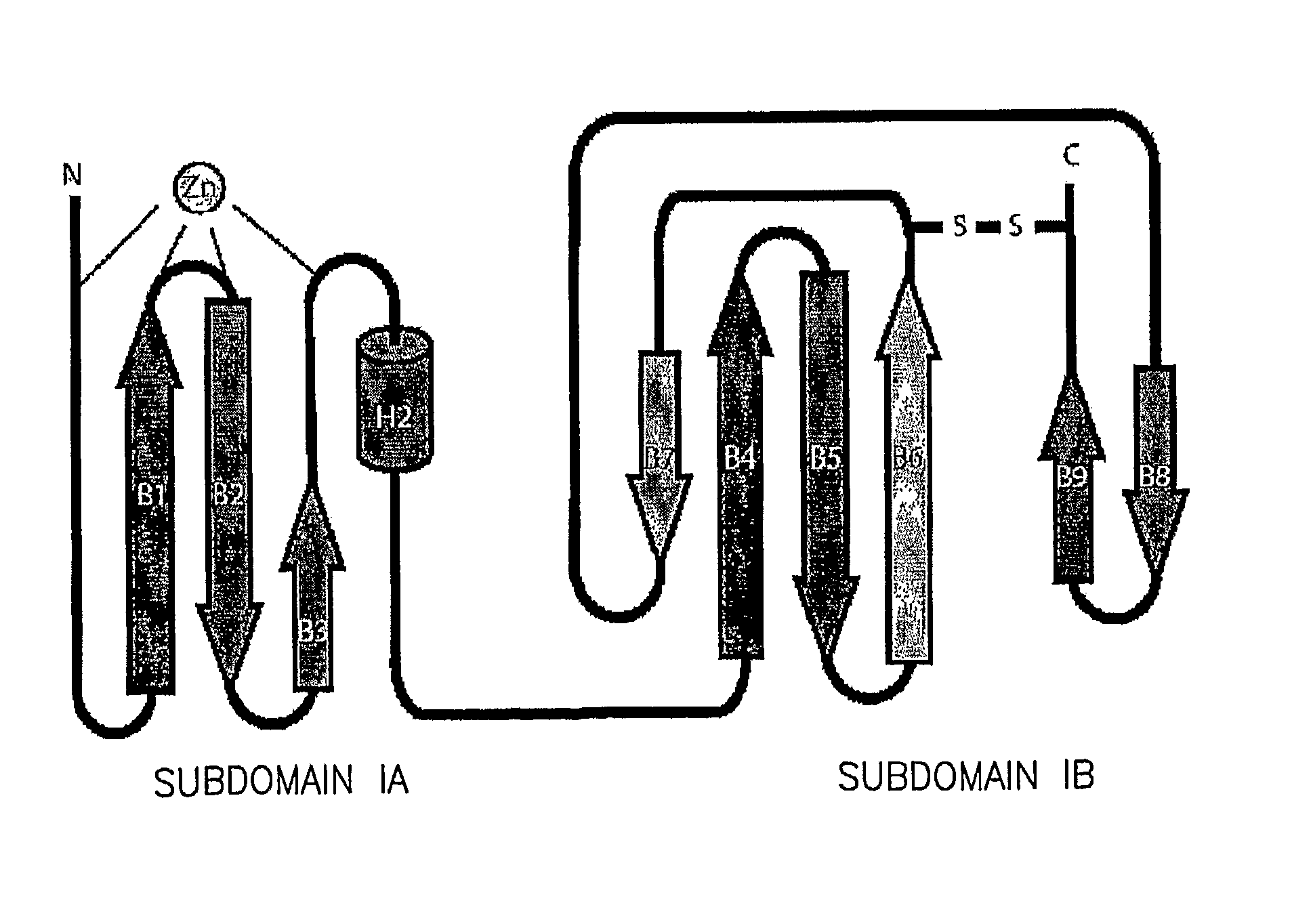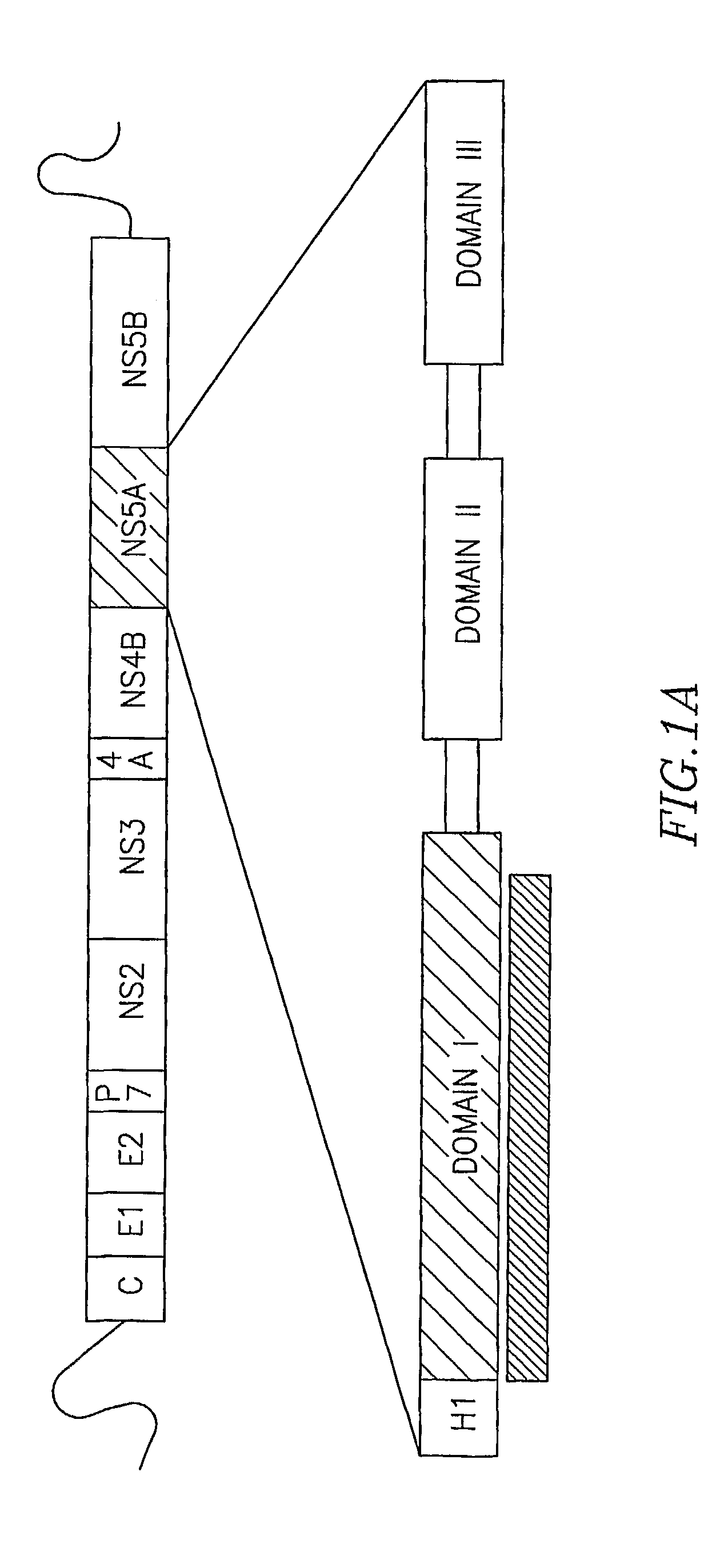Structure of the hepatitis C NS5A protein
a technology of hepatitis c virus and ns5a protein, which is applied in the direction of viruses, material analysis using wave/particle radiation, peptides, etc., can solve the problems of insufficient antiviral therapy for the majority of patients, no vaccine exists for hcv, and specific pharmaceutical targeting of hcv proteins
- Summary
- Abstract
- Description
- Claims
- Application Information
AI Technical Summary
Benefits of technology
Problems solved by technology
Method used
Image
Examples
example 1
Architecture of NS5A Domain I
[0173]The crystal structure of domain I revealed two essentially identical monomers per asymmetric unit packed together as a dimer via contacts near the N-terminal ends of the molecules. A summary of the data collection and processing statistics is provided in table 1.
[0174]
TABLE 1Summary of data collection and refinement statisticsData CollectionPhasingWavelengthResolutionReflectionsCompletenessaRsyma,bPowerc(Å)(Å)measured / unique(%)(%)I / σ(I)a(anomalous)λ1 = 1.2834530.0-2.50301,420 / 17,992100 (99.9)6.9 (32)23.8 (4.7)1.18λ2 = 1.2838530.0-2.50302,219 / 17,992100 (99.9)4.5 (34)22.4 (4.3)1.25λ3 = 12706930.0-2.50314,341 / 18,007100 (100) 8.7 (27)35.6 (5.7)1.21figure of meritacentriccentricoverall0.480.400.46Refinement against λ3ResolutionCompletenessRcrystdRfreee(Å)Cut-offReflections(%)(%)(%)30.0-2.50|F| / σ|F| > 2.029,57092.522.128.6Root mean square deviationsThermal parametersThermal parametersBond lengthsBond anglesmainchain atomssidechain atoms0.00625 Å1.34°1.28...
example 2
The NS5A Zinc Binding Site
[0176]Previous experiments have demonstrated the coordination of a single zinc atom by the domain I region of NS5A. The coordination of this metal ion is absolutely required for RNA replication. The location of the four cysteines involved in zinc coordination (Cys 39, Cys 57, Cys 59, and Cys 80), in relation to predicted secondary structures surrounding these residues, suggested a model of the zinc binding site, that of a four stranded anti-parallel β-sheet with the zinc atom coordinated at one end of the sheet. Overall, the proposed model is quite similar to the actual organization of the NS5A zinc-binding site revealed herein. A view of subdomain IA (aa 36-100) highlighting the cysteine residues involved in zinc ion coordination is shown in FIGS. 2a and 2b. The anti-parallel β-sheet, composed of strands B1, B2, and B3, positioning Cys 57, Cys 59, and Cys 80 near the zinc-binding site is essentially as predicted. The long random coil region positioning Cys...
example 3
NS5A Domain I has a C-Terminal Disulfide Bond
[0178]Perhaps the most surprising observation from model building and refinement of the structure was the presence of a disulfide bond near the C-terminus of domain I. The disulfide bond connects the sidechains of the conserved Cys 142 and Cys 190, resulting in a covalent link between the loop exiting from β-strand B6 to the C-terminal extension of strand B9 (FIG. 2c). Model refinement without a disulfide at this position placed the sidechains of these cysteine residues in an unfavourable proximity. Refinement with the disulfide led to no problematic geometry for either cysteine residues, and generated a model that better fit the electron density (FIG. 2d). Density corresponding to the disulfide bond is present in both molecules of domain I in the asymmetric unit, providing two independent views of this feature. The disulfide bond in the model results in a sulfur-to-sulfur atom distance of 2.03 Å, an ideal value for bond formation. Althou...
PUM
| Property | Measurement | Unit |
|---|---|---|
| pH | aaaaa | aaaaa |
| pH | aaaaa | aaaaa |
| cell density | aaaaa | aaaaa |
Abstract
Description
Claims
Application Information
 Login to View More
Login to View More - R&D
- Intellectual Property
- Life Sciences
- Materials
- Tech Scout
- Unparalleled Data Quality
- Higher Quality Content
- 60% Fewer Hallucinations
Browse by: Latest US Patents, China's latest patents, Technical Efficacy Thesaurus, Application Domain, Technology Topic, Popular Technical Reports.
© 2025 PatSnap. All rights reserved.Legal|Privacy policy|Modern Slavery Act Transparency Statement|Sitemap|About US| Contact US: help@patsnap.com



